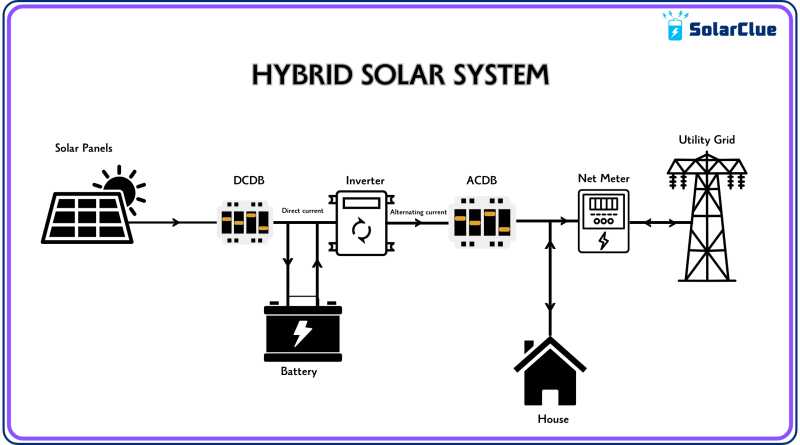Hybrid Solar System Diagram
A hybrid solar system is an advanced energy solution that combines solar power generation with battery storage and often includes a connection to the utility grid. This system allows for the generation of electricity through solar panels, the storage of excess energy in batteries, and the use of grid power when necessary. Hybrid solar systems offer increased reliability and efficiency, making them a popular choice for homes and businesses looking to reduce their dependence on traditional power sources.
In this blog, we will explore the key components of a hybrid solar system as depicted in the diagram, discuss the benefits of using such a system, and provide guidance on how to design your own hybrid solar setup.
Table of Contents
- 1 Components of a Hybrid Solar System Diagram
- 2 Benefits of a Hybrid Solar System
- 3 How to Design a Hybrid Solar System Diagram
Components of a Hybrid Solar System Diagram
Solar Panels: Convert Sunlight into Electricity
The solar panels are the primary source of energy in a hybrid solar system. They capture sunlight and convert it into direct current (DC) electricity. The effectiveness of solar panels depends on factors such as their efficiency and the amount of sunlight they receive.
Battery Storage: Store Excess Energy for Later Use
The battery storage system is an essential part of a hybrid system, allowing excess energy generated during the day to be stored and used later, such as during the night or on cloudy days. This feature ensures that your home remains powered even when solar energy generation is low.
Inverter: Convert DC Electricity into AC Electricity
The inverter plays a crucial role in a hybrid solar system by converting the DC electricity produced by the solar panels and stored in the batteries into alternating current (AC) electricity, which is used by most household appliances.
Net Meter and Utility Grid: Connect to the Grid for Additional Power
The net meter tracks the flow of electricity between your hybrid solar system and the utility grid. It allows for the export of excess electricity back to the grid, and when needed, the grid can provide additional power to your home. This ensures that your home always has a reliable power supply.
Benefits of a Hybrid Solar System
Increased Energy Efficiency and Reliability
A hybrid solar system optimizes energy efficiency by utilizing solar power first, storing excess energy, and providing a reliable backup during power outages. This makes it a highly efficient and dependable energy solution.
Reduced Electricity Bills
By generating and storing your electricity, a hybrid system significantly reduces your reliance on grid power, leading to lower electricity bills. The ability to sell excess electricity back to the grid through net metering can further enhance your savings.
Environmental Benefits of Using Renewable Energy Sources
Using solar energy reduces your carbon footprint by decreasing your reliance on fossil fuels. A hybrid solar system maximizes the use of clean, renewable energy, contributing to a more sustainable future.
How to Design a Hybrid Solar System Diagram
Assess Energy Needs and Consumption Patterns
Understanding your household’s energy consumption patterns is the first step in designing a hybrid solar system. This will help determine the size of the solar panels and the capacity of the battery storage needed.
Determine the Size and Number of Solar Panels Needed
The number of solar panels required depends on your energy needs and the available roof space. Panels should be positioned to receive maximum sunlight throughout the day.
Select Appropriate Battery Storage Capacity and Type
Choosing the right battery storage is critical for ensuring that your hybrid solar system can meet your energy needs during periods of low sunlight. Factors to consider include the battery type (e.g., lithium-ion) and its storage capacity.
Consider Factors Such as Location, Shading, and Budget
Location and shading can significantly impact the performance of your solar panels. Additionally, it’s important to consider your budget when selecting components for your hybrid solar system.
Conclusion
Recap of the Advantages of Using a Hybrid Solar System
A hybrid solar system offers numerous benefits, including energy efficiency, reliability, reduced electricity bills, and environmental sustainability. It is an excellent choice for homeowners and businesses looking to take control of their energy consumption.
Investing in a hybrid solar system is a proactive step towards reducing your carbon footprint and achieving energy independence. With the growing importance of renewable energy, now is the perfect time to explore this technology.
Final Thoughts
As the world continues to shift towards sustainable energy sources, hybrid solar systems are set to play a significant role in shaping the future of energy consumption. By adopting this technology, you are not only investing in your future but also contributing to a cleaner, more sustainable planet.
Understanding how a hybrid solar system works is the first step towards making a smart investment in your energy future. If you’re ready to bring the benefits of a hybrid solar system into your home or business, SolarClue is here to help. Visit SolarClue today to explore our range of hybrid solar systems and get expert installation services. With SolarClue, you can enjoy reliable, renewable energy with the confidence that you have chosen a solution that meets your needs. Don’t wait—start your journey to energy independence with SolarClue now!

